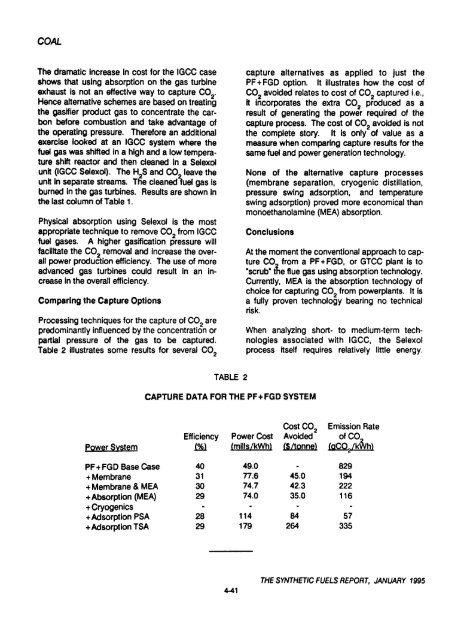Ikelic - Alliance Digital Repository
Ikelic - Alliance Digital Repository
Ikelic - Alliance Digital Repository
You also want an ePaper? Increase the reach of your titles
YUMPU automatically turns print PDFs into web optimized ePapers that Google loves.
COAL<br />
The dramatic increase in cost for the IGCC case<br />
shows that using absorption on the gas turbine<br />
exhaust is not an effective way to capture C02.<br />
Hence alternative schemes are based on treating<br />
the gasifier product gas to concentrate the car<br />
bon before combustion and take advantage of<br />
the operating pressure. Therefore an additional<br />
exercise looked at an IGCC system where the<br />
fuel gas was shifted in a high and a low tempera<br />
ture shift reactor and then cleaned in a Selexol<br />
unit (IGCC Selexol). The H2S and C02 leave the<br />
unit in separate streams. The cleaned fuel gas is<br />
burned in the gas turbines. Results are shown in<br />
the last column of Table 1 .<br />
Physical absorption using Selexol is the most<br />
appropriate technique to remove C02 from IGCC<br />
fuel gases. A higher gasification pressure will<br />
facilitate the C02 removal and increase the over<br />
all power production efficiency. The use of more<br />
advanced gas turbines could result in an in<br />
crease in the overall efficiency.<br />
Comparing the Capture Options<br />
Processing techniques for the capture of C02 are<br />
predominantly influenced by the concentration or<br />
partial pressure of the gas to be captured.<br />
Table 2 illustrates some results for several CO<br />
Power System<br />
PF+FGD Base Case<br />
+ Membrane<br />
+ Membrane & MEA<br />
+ Absorption (MEA)<br />
+ Cryogenics<br />
+ Adsorption PSA<br />
+ Adsorption TSA<br />
TABLE 2<br />
capture alternatives as applied to just the<br />
PF+FGD option. It illustrates how the cost of<br />
C02 avoided relates to cost of C02 captured i.e.,<br />
it incorporates the extra C02 produced as a<br />
result of generating the power required of the<br />
capture process. The cost of C02 avoided is not<br />
the complete story. It is only of value as a<br />
measure when comparing capture results for the<br />
same fuel and power generation technology.<br />
None of the alternative capture processes<br />
(membrane separation, cryogenic distillation,<br />
pressure swing adsorption, and temperature<br />
swing adsorption)<br />
proved more economical than<br />
monoethanolamine (MEA) absorption.<br />
Conclusions<br />
At the moment the conventional approach to cap<br />
ture CO from a PF+FGD, or GTCC plant is to<br />
"scrub"<br />
the flue gas using absorption technology.<br />
Currently, MEA is the absorption technology of<br />
choice for capturing from powerplants. It is<br />
C02<br />
a fully proven technology bearing no technical<br />
risk.<br />
When analyzing short- to medium-term tech<br />
nologies associated with IGCC, the Selexol<br />
process itself requires relatively<br />
CAPTURE DATA FOR THE PF+FGD SYSTEM<br />
Efficiency<br />
m<br />
40<br />
31<br />
30<br />
29<br />
28<br />
29<br />
4-41<br />
Power Cost<br />
(mills/kWm<br />
49.0<br />
77.6<br />
74.7<br />
74.0<br />
114<br />
179<br />
Cost C02<br />
Avoided<br />
($/tonne)<br />
45.0<br />
42.3<br />
35.0<br />
84<br />
264<br />
Emission Rate<br />
ofC02<br />
(oCOa/KWTi)<br />
829<br />
194<br />
222<br />
116<br />
57<br />
335<br />
little energy.<br />
THE SYNTHETIC FUELS REPORT, JANUARY 1995















![pace SrntfletIc fne]its report - Alliance Digital Repository](https://img.yumpu.com/10493335/1/190x245/pace-srntfletic-fneits-report-alliance-digital-repository.jpg?quality=85)
